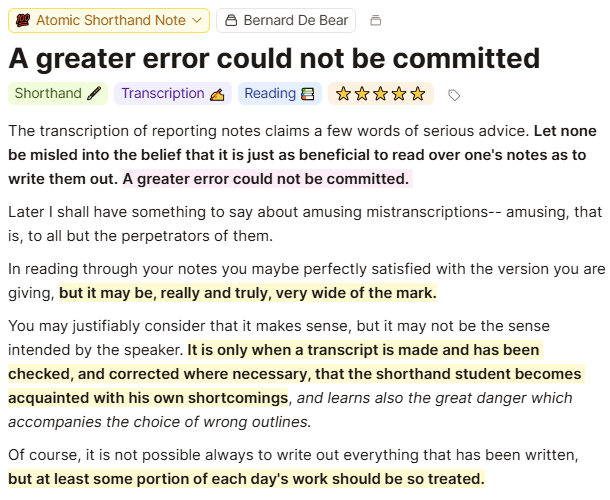LLTT Newsletter - March 2025

LLTT - March 2025

Welcome to all of our new subscribers this month! You've joined an excellent group of Teeline enthusiasts who are passionate about mastering this valuable skill. Whether you're a beginner or looking to improve your speed, you're in good company.
Understanding and Correcting Your Shorthand Errors
When you're learning shorthand, making mistakes is not just normal - it's an essential part of the learning process. However, what matters more is how you handle those mistakes and what you learn from them.
Here are some thoughts for your revision work.
Basic Error Notation
First, let's talk about how to mark errors in your notes. When you make a mistake, draw a ring around the incorrect outline - don't cross it out or try to write over it. Then write the correct outline in the margin. This keeps your notes clean and readable, which is crucial since shorthand notes may need to be referenced later or even used as evidence in certain professional contexts.
A note for those who are taking exams: Your outlines cannot be altered during or after dictation. However, it is perfectly acceptable - indeed recommended - that any “iffy” outlines (or even blanks) may be ringed and the correct outline written in the margin--on the same line as the questionable (or missing) outline.
Types of Errors
As you practise, you'll likely encounter several common types of errors.
Formation errors happen when outlines aren't properly shaped - perhaps a curve isn't quite right or an angle is off.
Position errors occur when characters aren't properly placed relative to the writing line, like writing a T too low or a D too high.
Proportion errors happen when the size relationships between characters are incorrect.
You might also encounter joining errors, where the connections between characters are awkward or incorrect.
Theory application errors occur when you misapply shorthand rules.
When writing at higher speeds, you'll experience some speed-related distortions where outlines become messier or less precise.
And finally, there are word grouping errors, where phrases that should be joined are separated or vice versa.
Analysing Your Mistakes
After taking notes, review them while the material is still fresh in your mind. Compare your outlines with the correct versions. Look for patterns - are you consistently making the same mistake? Do certain errors only appear when you're writing above a certain speed? Do they happen more frequently when you're tired?
Keep a simple error log
It is highly recommended to take note as to what kinds of mistakes you make most often and under what circumstances they occur. Although almost no one takes this to heart, if you do, you will find this information is invaluable for focusing your practice efforts where they're most needed.
Building Better Practice Habits
Once you've identified your common errors, you should work on targeted practice drills. If you struggle with certain letter combinations, practise those in isolation before attempting them at full speed. If certain outlines become distorted above specific speeds, practice them with progressive speed building - start slow and gradually increase your pace while maintaining accuracy.
If there is one thing we would tell you, it surely would be this: Prevention is better than correction.
Finally, develop good habits like proper warm-up routines for your hands, regular outline practice sessions, and maintaining focus during dictation. Pay attention to your posture and pen grip - poor ergonomics often lead to distorted outlines.
Tracking Your Progress
Keep track of your error rates over time. This doesn't need to be complicated - simply noting the number and types of errors in each practice session can be enlightening. Watch for improvement in your problem areas and document which correction strategies work best for you.
The Role of Speed
As you increase your writing speed, you'll likely see an increase in errors. This is normal and expected. The key is finding the sweet spot where you're pushing your speed while maintaining your accuracy. Remember that accuracy is more important than raw speed.
Final Thoughts
Error analysis isn't about being perfect; it's about continuous improvement. And if you never stop to consider what isn’t working, you will not have the opportunity to improve.
Every mistake is an opportunity to refine your technique and become a more skilled shorthand writer. Be systematic in your approach to errors, but don't let them discourage you. With consistent practice and careful attention to correction, you'll see steady improvement in both your speed and accuracy.
Note: This is a good time to refresh on The Critical Role of Enthusiasm in Mastering Shorthand, which is from our August 2024 newsletter.
Shorthand Sabotage: Common Pitfalls To Avoid When Learning Teeline

Every skill has its pitfalls that can slow progress. Based on our Beginner's Series principles, here are some key reminders for your Teeline journey:
Don't ignore the importance of size and proportion in your outlines. Lesson 1 explicitly introduces ‘babies, teenagers, and adults’ to represent the different letter heights. Failing to differentiate these sizes can lead to confusion and transcription errors later on. Pay attention to the relative size of your strokes.
Don't neglect the foundational alphabet. The lessons are structured around learning the alphabet in two halves. Skipping practice or not fully memorizing these fundamental steps will make forming words and understanding more advanced concepts much harder.
Don't write every letter of a word. The core principle of Teeline is skeletonising words. Ignoring this will defeat the purpose of learning shorthand, which is to write faster. Remember, ‘about two-fifths of the characters we write are unnecessary’ for comprehension.
Don't overlook special outlines. The lessons introduce special outlines from the very beginning, where single letters or unique outlines can represent entire common words. Neglecting to learn these ‘reduced’ forms will significantly slow down your writing speed.
Don't disregard word groupings. Lessons 3 and onwards emphasise the crucial role of joining common words together. Writing each word separately when a grouping exists is inefficient and misses a key speed-building technique.
Familiarise yourself with the Cautionary Words. Failing to apply these slight variations can lead to confusion when you try to transcribe your notes.
Don't avoid practising blends. Lessons introduce various blends (FR, FL, etc.) which form a large part of Teeline theory. Hesitating or writing these out as separate letters will slow you down. Aim to be confident with your blends.
Don't ignore the direction of vowel indicators. Vowel indicators are essential for accurate transcription. Pay attention to their direction and placement.
Don't skip dictation exercises. Dictation is critical for applying the theory, building speed, and getting used to hearing words and writing them in shorthand.
Don't be afraid to make mistakes. Learning takes time and practice. Don't get discouraged by errors. Instead, learn how to identify them and focus on practicing those areas.
Don't neglect regular practise. The lessons encourage consistent practice. Even short, regular sessions are more effective than infrequent long ones. As emphasised, it's important to do it every single day.
Don't be afraid to adapt (within reason). While the core principles are important, the lessons sometimes present alternatives. However, don't deviate too much from the methods taught without understanding the rationale. The goal is clarity first, then speed.
Don't underestimate the power of repetition (drilling). Notwithstanding the old joke that ‘A drill is for boring holes and shorthand students,’ repetition helps commit outlines to muscle memory.
If you’re looking for Teeline reading practice, Skill Building Through Reading 📗 - is available for purchase online.
Much work (and ❤️!) has gone into this 48 page, 6x9 softcover book:
Five 5️⃣ carefully selected passages: Improve your sight 👁️ recognition of outlines and word groupings.
Dual Format: Each passage includes both printed Teeline and the longhand ✍️ transcription.
Proven Learning Approach: Reading printed 🖨️ shorthand is a method long-favoured by skilled practitioners.
Whether you're a student, journalist, or professional seeking to improve your note taking, this book will be a valuable addition to your Teeline learning resources.
To order, please visit the book’s landing page or respond to this email with any questions.
If you find this newsletter helpful, please help us spread the word and forward to a friend!
Don’t forget, you can find us at the LLTT Website, YouTube, Facebook, Instagram, Quizlet and on Soundcloud.
A Parting Thought


